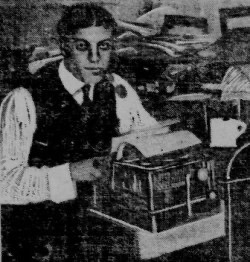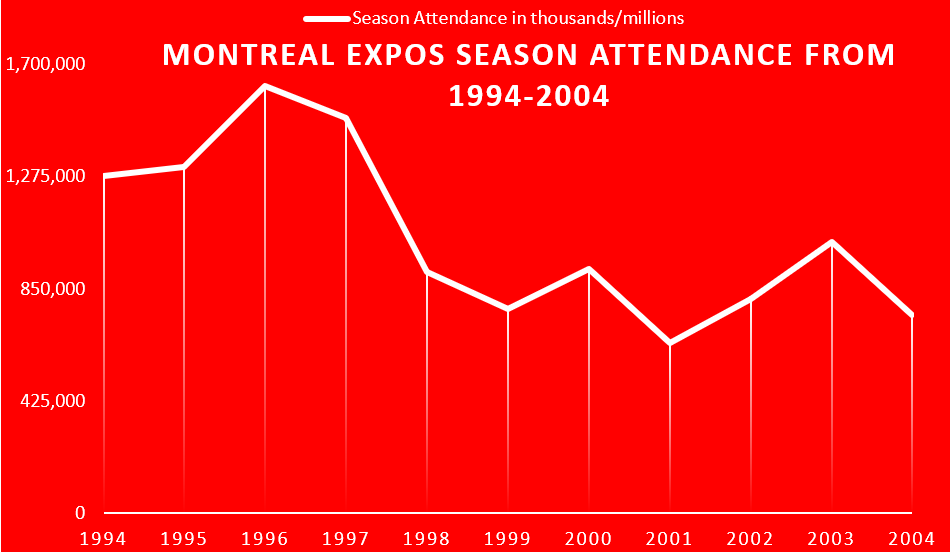1994-95 baseball strike ruined chances for records and the gradual demise of the Montreal Expos
- John Butler

- Feb 15, 2020
- 6 min read
Updated: Dec 2, 2021

Pedro Martinez fires a pitch during a game with the Montreal Expos where he wore the blue pinstripes from 1994-1997. Photo by The Montreal Expos.
Jack Butler jbutle58@lakers.mercyhurst.edu
ERIE, Pennsylvania – In 1994, the Montreal Expos were the most complete team in the majors as they commanded first place of the National League East and fans envisioned them playing for a World Series. The Expos had up and coming stars Larry Walker and Moises Alou, speedster Marquis Grissom, fine hitting Wil Cordero and four good hurlers Ken Hill, Pedro Martinez, Jeff Fassero and Butch Henry. Felipe Alou, Moises’s father, managed them to an impressive 54-33 mark at the All-Star break and won 20 of the 27 games after it. But, one city’s dreams of capturing baseball immortality, unfortunately, began to collapse because players worried about the looming threat of a salary cap, so they went on strike on Friday, August 12, 1994. All games that day were canceled, and owners and fans did not know how it would play out. The players went on strike due to the Major League Baseball Players Association (MLBPA) vetoed the owner's desire to implement revenue sharing with the use of a salary cap. Also, the 31 players on the union’s executive board had unanimously voted two weeks previously if an agreement wasn’t reached, they would go on strike. The news was devastating for the whole league and particularly awful for Bud Selig, the then-acting MLB commissioner.
With the strike starting during the heat of the pennant races it shifted the focus away from the games toward MLB attempting to resolve the issue. However, with no deal getting done the owners from all 24 MLB teams voted to cancel the rest of the season and Selig made the announcement on September 14. It was the first time in 90 years that a World Series would not be played while also being the first professional sport to lose its whole postseason because of a labor dispute.
By canceling the season, it ruined chances for records to be broken, feats to be achieved, and crushed baseball fans around American. Tony Gwynn, known as Mr. Padre in San Diego, was hitting .394 in 1994 in pursuit of producing the first .400 batting average since Ted Williams did it in 1941. The strike denied Gwynn a chance at history and it happened to San Francisco Giants third baseman Matt Williams as well. Williams hit 43 home runs up to August 12 and only needed 19 more to break the single-season record set by Yankee Roger Maris in 1961. The Giants star did not swing the bat in an actual game next until April of 1995. Besides ballplayers' opportunities for history being taken away, so were the New York Yankees to make the postseason. The Yankees had a 70-43 record which led the AL East who were destined for its first World Series appearance since 1978. Once again, the strike ended a team’s season and the Bronx Bombers would not have to wait long as they would capture the Fall Classic four times during the next six years. More importantly, the cancellation of the season resulted in the gradual downfall of the Montreal Expos.

San Diego Padres outfielder Tony “Mr. Padre” Gwynn takes a cut during an at-bat versus the Chicago Cubs at Wrigley Field in August 1994. In that year Gwynn came the closet in the modern era to hit .400 in a season, however, the strike ended that opportunity, and nobody has come close since. Photo by Frank Polich / Associated Press
For 232 days the players went on strike which came to end on April 2, 1995, when owners accepted their unconditional offer to return to work, made on March 31 after a U.S. District judge announced an injunction resorting terms and conditions of the expired agreement. 25 days later, the 1995 season began on Thursday, April 27 and the Montreal Expos went from a shortened first-place finish to an abysmal fifth place at 66-78. So, what happened to a ball club that one year were destined for the Fall Classic to become one of the worst teams in the National League the following season? The answer lies with the moves the Expos front office made during the 1994 offseason. Between the days of April 5-8, 1995 Ken Hill was traded to the St. Louis Cardinals, Marquis Grissom was dealt to the Atlanta Braves, and Larry Walker signed with the Colorado Rockies. These transactions lost the Expos their two starting outfielders and a fifth of their starting rotation which created big shoes to be filled. Unfortunately, they were not and as a result, Montreal began its first of eight 4th place finishes or worse in the NL East.
Following the 1996 campaign, Moises Alou granted free agency and signed with the Florida Marlins who was another star to be dealt and a fifth was traded an offseason later. Pedro Martinez turned himself into one of the best pitchers in the NL, but Expos management did not have the funds to pay him, so they shipped him to the Boston Red Sox and the rest is history.
In the season after Montreal dealt Martinez, Vladimir Guerrero began to become a phenomenal hitter and had a cannon of an outfield arm. Guerrero hit .324, had 202 base hits, 37 homers and 109 runs driven in during the 1998 campaign. With a ballplayer like Guerrero, who for the next five seasons displayed consistency at the plate and in the field, it looked like the franchise would stay in Canada. However, Vladdy deemed to become a free agent, then signed with the Los Angeles Angels of Anaheim where he played there for six seasons. By losing Guerrero the Expos had little hope while at the same time struggled to draw large home crowds at Stade Olympique.
The crowds began to decline significantly following the 1997 season when Montreal drew only 914,909 spectators which were a loss of 582,700 fans from the year prior. This trend kept getting worse for the final six years of the Expos' existence as in 1999 the team averaged a horrendous 9,540 people per game and 772,737 for the whole season. In the first season of the new millennium, Montreal gained 153,535 fans from 1999 to 2000 but did not even raise the total attendance to 1 million. Even with the small increase, fewer spectators watched them play baseball in 2001 with only 642,743 people which was the lowest single-season total in franchise history. During the next two campaigns the Expos gained more fans as in 2002 and 2003 there were 812,537 and 1,025,639 spectators respectively. Unfortunately, the organization’s last season in Montreal did not receive enough attendance with just 748,550 fans watching them play. The problem with fan attendance was one of many issues hurting the Expos with financial problems and MLB involvement were also present.
In 2001, Commissioner Bud Selig declared baseball had chosen to contract from 30 to 28 clubs and one of the clubs targeted was the Expos. However, a new collective bargaining agreement prohibited baseball from implementing the contraction before 2006. So, Major League Baseball bought and operated the Expos while installing Hall of Famer Frank Robinson as manager. The organization was constrained by fiscal limitations placed upon it to the point where the club did not have the funds to afford nominal payments necessary to minor league call up players. Now with contraction off the board, Selig searched for a new buyer and a new location for the Expos, finally settling on the nation’s capital, Washington D.C and were called the Nationals.
Since the Nationals began to play in 2005 the franchise has mostly had a season attendance over 2 million, made the playoffs six times while also claiming the 2019 World Series. So, if the 1994 baseball strike never occurred would the Montreal Expos win the Fall Classic that year? It is a tough question to answer but possibly the team is still in Montreal in 2020.
Appendix

The Montreal Expos season attendance decreased significantly following the 1997 campaign as it lost 582,700 fans in 1998. These numbers continued to decline and in 2001 only 642,743 spectators watched them play. Graph by Jack Butler .

Just as the season attendance graph displayed, after the 1997 campaign the Expos average fans per game declined drastically as well. From 1997 to 1998 Montreal lost 7,194 spectators and the lowest it ever got was just 7,935 in 2001. Graph by Jack Butler.
Sources
Associated Press. Timeline of baseball's labor troubles. ESPN, 2006, October 23. Retrieved February 15, 2020, from https://www.espn.com/mlb/news/story?id=2635604
Baseball Almanac. (2020). Washington Nationals Attendance [Data File]. Retrieved from https://www.baseball-almanac.com/teams/montattn.shtml
Baseball Reference. (2020). 1994 Montreal Expos Statistics. [Data File]. Retrieved from https://www.baseball-reference.com/teams/MON/1994.shtml
Baseball Reference. (2020). 1995 Montreal Expos Statistics. [Data File]. Rretrived from https://www.baseball-reference.com/teams/MON/1995.shtml
Baseball Reference. (2020). 1995 Montreal Expos Trades and Transactions. [Data File].Retrived from https://www.baseball-reference.com/teams/MON/1995-transactions.shtml
Baseball Reference. (2020). 1996 Montreal Expos Trades and Transactions. [Data File]. Retrieved from https://www.baseball-reference.com/teams/MON/1996-transactions.shtml
Baseball Reference. (2020). 1997 Montreal Expos Trades and Transactions.[Data File]. Retrieved from https://www.baseball-reference.com/teams/MON/1997-transactions.shtml
Craig Calcaterra. (2019, August 12). Baseball strike in 1994-95 began 25 years ago. NBC Sports. Retrieved February 15, 2020, from https://mlb.nbcsports.com/2019/08/12/baseball-strike-in-1994-95-began-25-years-ago/
Tim Kurkjian. (2019, August 12). Oh my God, how can we do this?: An oral history of the 1994 MLB strike. ESPN. Retrieved February 15, 2020, from https://www.espn.com/mlb/story/_/id/27161035/oh-my-god-how-do-oral-history-1994-mlb-strike
Joesportsfan. (2009, September 14). September 14, 1994: Baseball's Season is Canceled. Bleacher Report. Retrieved February 15, 2020, from https://bleacherreport.com/articles/254214-september-14-1994-baseballs-season-is-canceled







Comments